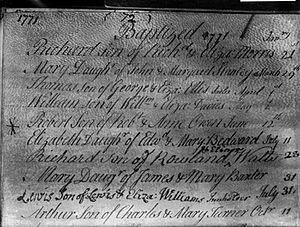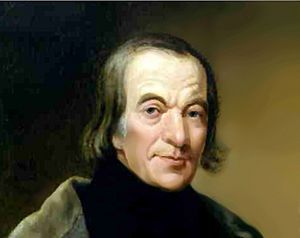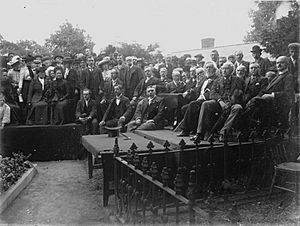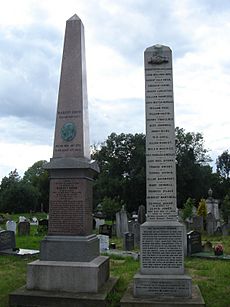Robert Owen facts for kids
Quick facts for kids
Robert Owen
|
|
|---|---|

Owen, aged about 50,
by William Henry Brooke |
|
| Born | 14 May 1771 |
| Died | 17 November 1858 (aged 87) Newtown, Montgomeryshire, Wales, United Kingdom of Great Britain and Ireland
|
| Occupation | co-operator; social reformer, textile mill co-owner; philanthropic capitalist |
| Spouse(s) | Ann (or Anne) Caroline Dale |
| Children | Jackson Dale (born 1799) Robert Dale (born 1801) William (born 1802) Ann (or Anne) Caroline (born 1805) Jane Dale (born 1805) David Dale (born 1807) Richard Dale (born 1809) Mary (born 1810) |
| Parent(s) | Robert Owen and Anne (Williams) Owen |
Robert Owen (born May 14, 1771 – died November 17, 1858) was a Welsh businessman and social reformer. He is known as a founder of utopian socialism and the cooperative movement. Owen worked to make factory conditions better for workers. He also started experimental communities where people lived and worked together. He believed in a more shared way of raising children, including government-supported education.
Owen became wealthy in the early 1800s from a textile mill in New Lanark, Scotland. He started as a draper (someone who sells cloth) in Stamford, Lincolnshire. Then he worked in London before moving to Manchester at age 18 to work in textile manufacturing. In 1824, he moved to America. He used most of his money to start an experimental community called New Harmony, Indiana. This community was meant to be a step towards his ideal society, but it only lasted about two years. Other communities he helped start also failed.
In 1828, Owen returned to London. There, he kept fighting for the rights of working-class people. He helped develop cooperatives and the trade union movement. He also supported laws to protect child workers and pushed for free schools that boys and girls could attend together.
Contents
Early Life and Education
Robert Owen was born in Newtown, a small town in Montgomeryshire, Wales, on May 14, 1771. His parents were Anne (Williams) and Robert Owen. His father was a saddler, an ironmonger (someone who sells metal goods), and the local postmaster. His mother came from a farming family in Newtown. Robert was the sixth of seven children. Two of his siblings died young. His surviving siblings were William, Anne, John, and Richard.
Owen did not have much formal schooling. However, he loved to read. He left school at age ten to become an apprentice to a Stamford, Lincolnshire draper. He worked there for four years. In his teenage years, he also worked in drapery shops in London. Around age 18, Owen moved to Manchester. He spent the next twelve years there, first working at Satterfield's Drapery.
While in Manchester, Owen borrowed £100 from his brother William. He used this money to become a partner in a business that made spinning mules. These were new machines for spinning cotton thread. After a few months, he traded his share in the business for six spinning mules. He used these in a rented factory space. In 1792, when Owen was about 21, a mill owner named Peter Drinkwater made him manager of the Piccadilly Mill in Manchester. After two years, Owen left that company. He then partnered with other business people to start and manage the Chorlton Twist Mills.
By the early 1790s, Owen's business skills and advanced ideas about society were becoming clear. In 1793, he joined the Manchester Literary and Philosophical Society. This group discussed new ideas from the Enlightenment. He also became a committee member of the Manchester Board of Health. This group worked to improve the health and working conditions for factory workers.
Marriage and Family Life
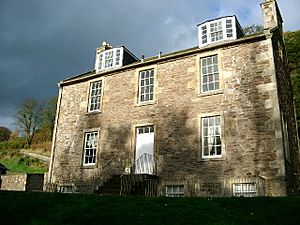
During a trip to Scotland, Owen met and fell in love with Ann (or Anne) Caroline Dale. She was the daughter of David Dale, a kind businessman from Glasgow. David Dale owned the large New Lanark Mills. Robert and Ann married on September 30, 1799. They first lived in New Lanark, then moved to Braxfield House in Lanark, Scotland.
Robert and Caroline Owen had eight children. Their first child died as a baby. Their seven surviving children were four sons and three daughters:
- Robert Dale (1801–1877)
- William (1802–1842)
- Ann (or Anne) Caroline (1805–1831)
- Jane Dale (1805–1861)
- David Dale (1807–1860)
- Richard Dale (1809–1890)
- Mary (1810–1832)
Owen's four sons and his daughter Jane Dale moved to the United States with their father. They became US citizens and lived permanently in New Harmony, Indiana. Owen's wife Caroline and two of their daughters, Anne Caroline and Mary, stayed in Britain. They died there in the 1830s.
Improving Factory Life at New Lanark
In July 1799, Owen and his business partners bought the New Lanark mill from David Dale. Owen became its manager in January 1800. He wanted to run the New Lanark mill based on good principles, not just for making money. The mill had been started in 1785 by David Dale and Richard Arkwright. It used water power from the River Clyde to spin cotton. It became one of Britain's largest mills. About 2,000 people worked there, including 500 children. These children, as young as five or six, came from poorhouses and charities in Edinburgh and Glasgow. David Dale was known for being kind and treated the children well. However, the overall living conditions for New Lanark residents were not good, even with efforts by Dale and Owen to improve them.
Many workers came from very poor backgrounds. Theft, drunkenness, and other problems were common. Education and cleanliness were often ignored. Most families lived in just one room. More respected people avoided the long hours and hard, boring work of the mills.
Before laws called Truck Acts (1831–1887) made employers pay workers in regular money, many factories used a "truck system." Workers were paid with tokens that could only be used at the mill owner's "truck shop." These shops often charged high prices for low-quality goods. Owen's store was different. It sold goods at prices only slightly higher than what he paid for them. He passed on the savings from buying in bulk to his customers. He also closely watched alcohol sales. These ideas became the foundation for Britain's Co-operative shops, some of which still exist today.
Owen's Ideas and Influence
Owen tested his social and economic ideas at New Lanark. He earned the trust of his workers and made the mill more efficient and successful. The community became famous around the world. Social reformers, politicians, and even royalty, like the future Tsar Nicholas I of Russia, visited New Lanark to see how it worked. Many visitors were impressed.
Owen's biggest success was in supporting education for young people and early child care. He was a pioneer in Britain, especially Scotland, for offering a different way to educate children. Unlike the strict methods of the time, Owen's system encouraged children to be graceful, friendly, and free. People said that health, plenty, and happiness were common there. Drunkenness was almost unheard of, and very few children were born outside of marriage. Owen got along very well with his workers. The mill ran smoothly and made good money.
However, some of Owen's ideas did not please his business partners. This led him to find new investors to buy his share of the business in 1813. The new investors, including Jeremy Bentham and the Quaker William Allen, were happy to earn a set profit on their money. This change also gave Owen a chance to do more good. He started speaking out for workers' rights, laws against child labor, and free education for children.
In 1813, Owen wrote and published A New View of Society. This was the first of four essays explaining his ideas for social reform. Owen believed that a person's character is shaped by their surroundings, not just by themselves. So, people should not be praised or blamed for their actions or life situation. This led Owen to believe that to help people develop good characters, they needed to grow up in good environments. These environments should be physically, morally, and socially positive from a very young age. These ideas about how people are shaped by their surroundings formed the basis of Owen's education and social reform plans.
Owen's work at New Lanark continued to be important in Britain and Europe. He was a leader in factory reform, the father of the cooperative movement, and the founder of nursery schools. His plans for educating his workers included opening an Institute for the Formation of Character at New Lanark in 1818. This and other programs at New Lanark offered free education from infancy to adulthood. He also strongly supported factory laws, which led to the Cotton Mills and Factories Act of 1819. Owen also met with important members of the British government and leaders from other European countries.
Owen used new ways to improve the quality of goods his workers made. He placed a cube with different colored faces above each worker's station. The color showed everyone the quality and quantity of work the person had done. This was meant to encourage workers to do their best. Even though it wasn't a huge reward, conditions at New Lanark for workers and their families were very good for that time.
One of Owen's most famous ideas was his "silent monitor" method. Owen did not believe in physical punishment. Instead, he used a four-sided block with different colors. Each color showed how well an employee was doing. Black meant poor performance, and white meant excellent behavior. Owen believed this would make employees want to do better, as they cared about his opinion. This idea supported his belief that a person's character is shaped by their environment. Owen had a big impact on British socialism and trade unions. He showed that anyone, rich or poor, could challenge the way things were and make a difference.
Owen became known as a utopian socialist. He fought for laws that helped workers, like the Factory Act of 1819. His ideas did not immediately become popular in Britain or the United States.
The Eight-Hour Day
Owen was one of the first to ask for an eight-hour day in 1810. He started this policy at New Lanark. By 1817, he had a famous slogan: "eight hours labour, eight hours recreation, eight hours rest."
Models for a New Society
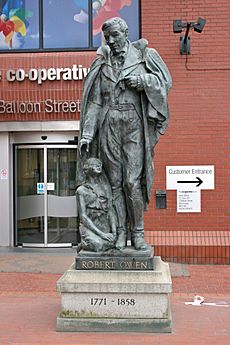
Owen fully supported socialism in 1817. This was a big moment in his life. He called his new approach a "New View of Society." He explained his ideas in a report to the House of Commons about the country's Poor Laws. After the Napoleonic Wars, there was a lot of poverty and slow trade. The government asked Owen for ideas to help with these problems. He believed the main problem was machines replacing human workers. He suggested creating self-sufficient communities.
Owen proposed communities of about 1,200 people living on 1,000 to 1,500 acres (405 to 607 ha) of land. Everyone would live in one large building with a shared kitchen and dining halls. Each family would have their own private rooms. Children up to age three would be cared for by their parents. After that, children would be raised by the community, but parents could still see them at mealtimes and other times. Owen thought these communities could be started by individuals, towns, or governments. He believed work and its benefits should be shared. Owen called his vision the "New Moral World."
Owen's ideal community model did not change much during his life. He imagined a group of 500–3,000 people as the best size for a working community. It would mainly be agricultural but would use the best machines. It would offer different types of jobs and try to be self-sufficient. Owen believed that as these communities grew, they would form "unions" of tens, hundreds, and thousands, connected by shared interests.
Community Experiments
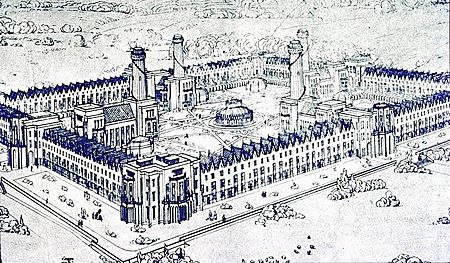
To test his ideas for self-sufficient communities, Owen started experiments in the United States in 1825. One of the most famous was at New Harmony, Indiana. Owen's New Harmony was his first and most ambitious project.
Owen and his son William sailed to the United States in October 1824. In January 1825, Owen used some of his own money to buy a town with 180 buildings and thousands of acres of land in Indiana. A religious group called the Harmony Society had owned the property. They had founded the village of Harmony (or Harmonie) there in 1814. Owen renamed it New Harmony. He made the village his first model for a Utopian community.
Owen sought support for his ideas from American thinkers, reformers, and politicians. In February and March 1825, Owen gave speeches in the House of Representatives to Congress and other government officials. He explained his vision for New Harmony and his socialist beliefs. His audience included three former U.S. presidents—John Adams, Thomas Jefferson, and James Madison—the outgoing President James Monroe, and the President-elect, John Quincy Adams. These meetings were likely the first time socialism was discussed in the Americas, especially in the United States. Owenism was one of the first socialist ideas in the United States.
Owen convinced William Maclure, a wealthy Scottish scientist, to join him at New Harmony and become his financial partner. Maclure's involvement attracted other scientists, educators, and artists. These included Thomas Say, Charles-Alexandre Lesueur, and Madame Marie Duclos Fretageot. They helped make New Harmony a center for education, science, and art.
Owen wanted to build a "Village of Unity and Mutual Cooperation" south of the town, but his big plan was never fully completed. He returned to Britain to continue his work. While he was away, Owen left the New Harmony experiment to be managed by his sons, Robert Dale Owen and William Owen, and his business partner, Maclure. However, New Harmony failed financially. It lasted about two years, even though it attracted over a thousand residents in its first year. The community was dissolved in 1827. But many of its scientists, educators, artists, and other residents, including Owen's four sons and his daughter Jane Dale Owen Fauntleroy, stayed in New Harmony after the experiment ended.
Other experiments in the United States included communities near Bloomington, Indiana; at Yellow Springs, Ohio; and at Forestville Commonwealth in Earlton, New York. There were also projects in New York, Pennsylvania, and Tennessee. Almost all of these ended before New Harmony was dissolved in April 1827.
Owen's communities attracted many different kinds of people. Some had very high goals. Others were wanderers, adventurers, or just people interested in reform. Owen's son David Dale Owen said they attracted "a mixed group of Radicals," "enthusiastic followers of principles," and "honest people with flexible views, and lazy thinkers," with "a few dishonest tricksters mixed in."
Josiah Warren, who was part of New Harmony, said it failed because it lacked individual sovereignty (people's right to control their own lives) and personal property. Warren explained that their "united interests" clashed with people's individual needs and their instinct to protect themselves. Warren's ideas about why the community failed led to the development of American individualist anarchism. Some historians believe New Harmony failed due to disagreements among its members.
Social experiments also started in Scotland in 1825. Abram Combe, a follower of Owen, tried a community at Orbiston, near Glasgow, but it failed after about two years. In the 1830s, more cooperative communities were tried in Ireland and Britain. The most important were at Ralahine, Ireland (1831), and at Tytherley, England (1839). Ralahine was very successful for three and a half years until the owner lost all his money gambling and had to sell it. Tytherley, also known as Harmony Hall or Queenwood College, also failed. Another community, Manea Colony in Cambridgeshire, started in the late 1830s by William Hodson (another Owenite), also failed in a couple of years.
Return to Britain
Although Owen made more short visits to the United States, London became his permanent home and the center of his work in 1828. After many disagreements with William Allen and other business partners, Owen ended all his connections with New Lanark. He is often remembered for a comment by Allen at the time: "All the world is queer save thee and me, and even thou art a little queer." Having invested most of his money in the failed New Harmony community, Owen was no longer a rich businessman. However, he continued to strongly promote industrial equality, free education for children, and good living conditions in factory towns. He gave lectures in Europe and published a weekly newspaper to gain support for his ideas.
In 1832, Owen started the National Equitable Labour Exchange system. This used a time-based currency where goods were exchanged using "labour notes." This system replaced regular money and middlemen. The London exchange lasted until 1833. A branch in Birmingham operated for only a few months. Owen also became involved in trade unions. He briefly led the Grand National Consolidated Trade Union (GNCTU) before it collapsed in 1834.
The term "socialism" first became common in Britain during discussions of the Association of all Classes of all Nations. Owen formed this group in 1835 and was its first leader. Owen's secular (non-religious) views also became popular among working-class people. However, by 1846, the only lasting result of Owen's efforts for social change was the Co-operative movement. Even that seemed to have failed for a while.
Later Life and Spiritualism

In 1817, Owen publicly stated that all religions were false. However, in 1854, at age 83, Owen became a believer in spiritualism. This happened after he attended several sittings with Maria B. Hayden, an American medium. He publicly announced his new faith in his publication The Rational Quarterly Review and in a pamphlet.
Owen claimed to have communicated with the spirits of famous people like Benjamin Franklin and Thomas Jefferson. He said the purpose of these contacts was to change "the present, false, disunited and miserable state of human existence, for a true, united and happy state... to prepare the world for universal peace, and to infuse into all the spirit of charity, forbearance and love."
After Owen's death, Spiritualists claimed that his spirit dictated the "Seven Principles of Spiritualism" to the medium Emma Hardinge Britten in 1871. These principles are used by their National Union as the basis of their religious beliefs.
Death and Lasting Impact
As Owen grew older and his ideas became more extreme, his influence began to fade. He published his life story, The Life of Robert Owen, in 1857, a year before he died.
Even though he spent most of his life in England and Scotland, Owen returned to his hometown of Newtown at the end of his life. He died there on November 17, 1858, and was buried on November 21. He died with no money, except for a yearly income from a trust set up by his sons in 1844.
Owen was a reformer, a kind person, a community builder, and a spiritualist. He spent his life trying to make others' lives better. He supported the working class and improved factory conditions, as shown at New Lanark. He became a leader in trade unions, promoted social equality through his experimental communities, and supported laws for child labor and free education. In these ideas, he was ahead of his time. He imagined a communal society that others could consider and use as they wished. In Revolution in the Mind and Practice of the Human Race (1849), he said that a person's character is shaped by nature (or God) and their life experiences. Based on the good results at New Lanark, Owen believed that a person's "character is not made by, but for the individual." He thought that nature and society are responsible for each person's character and actions.
Owen's efforts for social change, along with the work of his followers (Owenites) and his own children, led to lasting social reforms. These included improvements in women's and workers' rights, the establishment of free public libraries and museums, child care, and public, co-educational schools. He also helped develop the Co-operative and trade union movements. New Harmony, Indiana, and New Lanark, Scotland, are two towns closely linked to him. They remain as reminders of his work.
Owen's legacy of public service continued through his four sons and his daughter Jane, who followed him to America to live in New Harmony, Indiana:
- Robert Dale Owen (1801–1877) was a good supporter of his father's ideas. He managed the New Harmony community after his father returned to Britain in 1825. He wrote articles and helped edit newspapers in Indiana and New York City. Robert Dale Owen became active in Indiana politics. He was elected to the Indiana House of Representatives and the U.S. House of Representatives. He also served as a diplomat in Naples. While in Congress, he helped create a bill that founded the Smithsonian Institution in 1846. He supported property rights for widows and married women, and divorce rights. He also favored laws for Indiana's tax-supported public school system. Like his father, he believed in spiritualism and wrote two books about it.
- William Owen (1802–1842) moved to the United States with his father in 1824. His business skills, especially in cotton manufacturing, allowed him to stay at New Harmony after his father left. He advised the community. He also organized New Harmony's theater group in 1827. He died at age 40 from unknown causes.
- Jane Dale Owen Fauntleroy (1805–1861) arrived in the United States in 1833 and settled in New Harmony. She was a musician and educator who started a school in her home. In 1835, she married Robert Henry Fauntleroy, a civil engineer.
- David Dale Owen (1807–1860) moved to the United States in 1827 and lived in New Harmony for several years. He studied geology and natural science and earned a medical degree. He became a United States geologist in 1839. He did geological surveys in the Midwest, including Indiana, Iowa, Missouri, Arkansas, and Minnesota Territory. His brother Richard took over as Indiana's state geologist after him.
- Richard Dale Owen (1810–1890) moved to the United States in 1827 and joined his siblings in New Harmony. He fought in the Mexican–American War in 1847. He taught natural science at Western Military Institute in Tennessee from 1849–1859 and earned a medical degree in 1858. During the American Civil War, he was a colonel in the Union army. He served as a commander of Camp Morton, a prisoner-of-war camp for Confederate soldiers. After the war, Owen became Indiana's second state geologist. He was also a professor at Indiana University and led its natural science department from 1864–1879. He helped plan Purdue University and was its first president from 1872–1874, but he resigned before classes started and returned to teaching at Indiana University. He spent his retirement years doing research and writing.
Honors and Tributes
- The Co-operative Movement built a monument to Robert Owen in 1902 at his burial site in Newtown, Montgomeryshire.
- The Welsh people gave a bust (a sculpture of the head and shoulders) of Owen by Welsh sculptor Sir William Goscombe John to the International Labour Office library in Geneva, Switzerland.
- Manchester has a statue of Owen at Balloon and Commercial Streets.
Images for kids
See also
 In Spanish: Robert Owen para niños
In Spanish: Robert Owen para niños
- Cincinnati Time Store
- José María Arizmendiarrieta
- Labour voucher
- List of Owenite communities in the United States
- Owenstown
- Owenism
- William King


